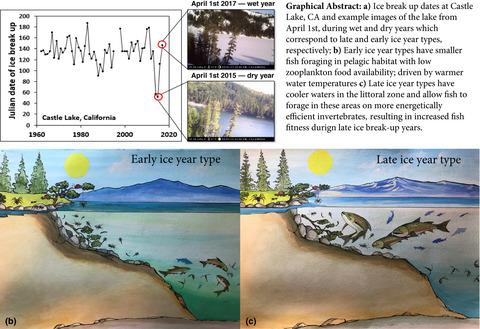当前位置:
X-MOL 学术
›
Glob. Change Biol.
›
论文详情
Our official English website, www.x-mol.net, welcomes your
feedback! (Note: you will need to create a separate account there.)
Ecosystem response to earlier ice break-up date: Climate-driven changes to water temperature, lake-habitat-specific production, and trout habitat and resource use.
Global Change Biology ( IF 10.8 ) Pub Date : 2020-06-29 , DOI: 10.1111/gcb.15258 Timothy J Caldwell 1, 2 , Sudeep Chandra 1, 2, 3 , Karly Feher 2 , James B Simmons 1, 2 , Zeb Hogan 2, 3
Global Change Biology ( IF 10.8 ) Pub Date : 2020-06-29 , DOI: 10.1111/gcb.15258 Timothy J Caldwell 1, 2 , Sudeep Chandra 1, 2, 3 , Karly Feher 2 , James B Simmons 1, 2 , Zeb Hogan 2, 3
Affiliation

|
Climate warming has yielded earlier ice break‐up dates in recent decades for lakes leading to water temperature increases, altered habitat, and both increases and decreases to ecosystem productivity. Within lakes, the effect of climate warming on secondary production in littoral and pelagic habitats remains unclear. The intersection of changing habitat productivity and warming water temperatures on salmonids is important for understanding how climate warming will impact mountain ecosystems. We develop and test a conceptual model that expresses how earlier ice break‐up dates influence within lake habitat production, water temperatures and the habitat utilized by, resources obtained and behavior of salmonids in a mountain lake. We measured zoobenthic and zooplankton production from the littoral and pelagic habitats, thermal conditions, and the habitat use, resource use, and fitness of Brook Trout (Salvelinus fontinalis). We show that earlier ice break‐up conditions created a "resource‐rich" littoral–benthic habitat with increases in zoobenthic production compared to the pelagic habitat which decreased in zooplankton production. Despite the increases in littoral–benthic food resources, trout did not utilize littoral habitat or zoobenthic resources due to longer durations of warm water temperatures in the littoral zone. In addition, 87% of their resources were supported by the pelagic habitat during periods with earlier ice break‐up when pelagic resources were least abundant. The decreased reliance on littoral–benthic resources during earlier ice break‐up caused reduced fitness (mean reduction of 12 g) to trout. Our data show that changes to ice break‐up drive multi‐directional results for resource production within lake habitats and increase the duration of warmer water temperatures in food‐rich littoral habitats. The increased duration of warmer littoral water temperatures reduces the use of energetically efficient habitats culminating in decreased trout fitness.
中文翻译:

生态系统对更早解冻日期的响应:气候驱动的水温变化,特定于湖泊栖息地的生产以及鳟鱼栖息地和资源利用。
近几十年来,由于气候变暖,湖泊的结冰时间更早,导致水温升高,栖息地改变以及生态系统生产力的上升和下降。在湖泊中,气候变暖对沿海和中上生境中次级生产的影响尚不清楚。栖息地生产力的变化与鲑鱼的水温升高之间的交集对于理解气候变暖将如何影响山区生态系统至关重要。我们开发并测试了一个概念模型,该模型表达了较早的解冰日期如何影响湖生境的产生,水温和利用的生境,获得的资源以及鲑鱼在高山湖泊中的行为。我们测量了沿岸和中上生境,热条件,底栖动物和浮游动物的生产,沙柳)。我们表明,较早的冰破坏条件创造了一个“资源丰富的”滨海底栖生境,与浮游动物产量下降的远洋生境相比,其底栖生物的产量增加了。尽管滨海底栖食物资源有所增加,但由于沿岸区的热水温度持续时间较长,鳟鱼并未利用滨海栖息地或游动性底栖动物资源。此外,在中冰资源最不丰富的早期破冰时期,中上层栖息地为他们的资源提供了87%的支持。早期破冰期间对沿海底栖动物资源的依赖减少,导致鳟鱼适应性降低(平均减少12 g)。我们的数据表明,冰破碎的变化推动了湖泊生境内资源生产的多方向结果,并增加了食物丰富的沿海生境中水温升高的持续时间。沿海水温升高的持续时间增加,减少了对能量有效利用的栖息地的使用,最终导致鳟鱼适应性下降。
更新日期:2020-06-29
中文翻译:

生态系统对更早解冻日期的响应:气候驱动的水温变化,特定于湖泊栖息地的生产以及鳟鱼栖息地和资源利用。
近几十年来,由于气候变暖,湖泊的结冰时间更早,导致水温升高,栖息地改变以及生态系统生产力的上升和下降。在湖泊中,气候变暖对沿海和中上生境中次级生产的影响尚不清楚。栖息地生产力的变化与鲑鱼的水温升高之间的交集对于理解气候变暖将如何影响山区生态系统至关重要。我们开发并测试了一个概念模型,该模型表达了较早的解冰日期如何影响湖生境的产生,水温和利用的生境,获得的资源以及鲑鱼在高山湖泊中的行为。我们测量了沿岸和中上生境,热条件,底栖动物和浮游动物的生产,沙柳)。我们表明,较早的冰破坏条件创造了一个“资源丰富的”滨海底栖生境,与浮游动物产量下降的远洋生境相比,其底栖生物的产量增加了。尽管滨海底栖食物资源有所增加,但由于沿岸区的热水温度持续时间较长,鳟鱼并未利用滨海栖息地或游动性底栖动物资源。此外,在中冰资源最不丰富的早期破冰时期,中上层栖息地为他们的资源提供了87%的支持。早期破冰期间对沿海底栖动物资源的依赖减少,导致鳟鱼适应性降低(平均减少12 g)。我们的数据表明,冰破碎的变化推动了湖泊生境内资源生产的多方向结果,并增加了食物丰富的沿海生境中水温升高的持续时间。沿海水温升高的持续时间增加,减少了对能量有效利用的栖息地的使用,最终导致鳟鱼适应性下降。











































 京公网安备 11010802027423号
京公网安备 11010802027423号